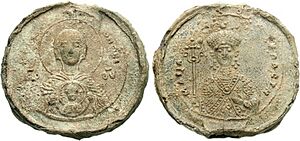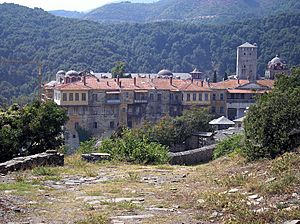Maria of Alania facts for kids
Quick facts for kids Maria of Alania |
|
|---|---|
| Mariam Bagrationi | |
 |
|
| Byzantine Empress consort | |
| Tenure | 1071–1081 |
| Born | 1053 Kingdom of Georgia |
| Died | 1118 (aged 64–65) Byzantine Empire |
| Spouse | Michael VII (1065–1078) Nicephorus III (1078–1081) |
| Issue | Constantine Doukas |
| Dynasty | Bagrationi dynasty |
| Father | Bagrat IV of Georgia |
| Mother | Borena of Alania |
| Religion | Georgian Orthodox Church |
Maria of Alania (born Martha, 1053–1118) was a powerful Byzantine empress. She became empress by marrying two different emperors: Michael VII Doukas and Nikephoros III Botaneiates.
Being an empress was a big deal for her home country, the Kingdom of Georgia. It showed Georgia's growing importance in the region. Maria was also special because she was the only foreign-born empress in the Byzantine Empire during the 1000s.
Contents
Early Life of Empress Maria
Maria, originally named Martha, was the daughter of Bagrat IV of Georgia, the king of Georgia. When she was just five years old, she was sent to Constantinople. This was the capital city of the Byzantine Empire.
She went there as a "hostage," which meant she was a guest who also helped ensure her father's good behavior. She was meant to get a good education at the Byzantine court. Empress Theodora was her protector. However, Theodora died later that same year in 1056, and Martha went back home to Georgia.
Empress with Michael VII
In 1065, Martha married Michael VII Doukas. He was the son of Emperor Constantine X Doukas. When Michael became emperor in 1071, Martha became Empress Maria.
Maria's first marriage was a tough time for the empire. Michael's armies faced many problems in Anatolia against the Seljuk Turks. The empire also had money troubles, which made people unhappy. This led to a coup in 1078. Michael was removed from power and Nikephoros III Botaneiates became the new emperor.
Michael was forced to become a monk. Maria and her son, Constantine, moved to a monastery. But Maria did not become a nun herself. This might have meant she still had plans for her future at the imperial court.
Empress with Nikephoros III
Nikephoros III's wife had died just before he became emperor. He wanted to remarry, and many women in Constantinople hoped to become empress. Maria, her former mother-in-law Eudokia Makrembolitissa, and Eudokia's daughter Zoe were all hoping to be chosen.
The new emperor first thought about marrying Eudokia. But Maria had strong support from her former in-laws, the Doukas family. They convinced Nikephoros to choose Maria. They said she was beautiful and that a foreign-born wife would not have relatives who could cause trouble in his rule. Also, marrying Maria would help calm down people who were still loyal to the old Doukas family.
As part of their marriage agreement, Maria was promised that her son Constantine would be named the next heir to the empire. However, Nikephoros later changed his mind about this promise. Even so, Maria was treated very well during his reign. She received huge amounts of land and property. Nikephoros even gave her brother, George II of Georgia, an important title called "Caesar." This showed his close connection to the imperial family.
Maria and the Second Imperial Change
According to Princess Anna Komnene, who was cared for by Maria, the empress was still unhappy. She was upset that Nikephoros would not name her son Constantine as the heir. Maria became an important part of a plan by the general Alexios Komnenos. Alexios later became emperor.
Alexios forced Nikephoros to give up his throne. Alexios was then crowned emperor in 1081.
Life During Alexios's Rule
At first, Alexios announced that Maria's son, Constantine, would be the heir to the throne. He even arranged for his own daughter, Anna Komnene, to marry Constantine. But things changed when Alexios had a son, John II Komnenos, in 1087. John later became emperor.
After John was born, Anna's engagement to Constantine was called off. Constantine lost his status as heir. Maria was then asked to retire to a monastery.
Even after being removed from power and spending some time in a monastery, Maria lived in the Mangana palace. She still had a lot of influence. She continued her charity work, like giving money to the Georgian monastery of Iviron on Mount Athos. She also helped build a convent in Jerusalem. Maria was very wealthy and owned the Mangana palace. She also owned the Hebdomon Monastery, where Emperor Basil II was buried. She supported many writers and thinkers, including Theophylact of Ohrid.
Maria's influence at court was clear. Her son Constantine received a higher title than the emperor's older brother. Maria was also guaranteed her personal safety. She was even put in charge of caring for the young Princess Anna Komnene, who loved Maria and shared all her secrets with her.
Princess Anna Komnene wrote about Maria's beauty in her famous book, Alexiad.
Later Years
Maria's son Constantine died in 1096. After this, she finally moved to a monastery for good. It is believed she went to a place in northeastern Anatolia, which had many Georgian people.
Maria remained a respected figure in her home country of Georgia. Her story helped lead to more marriages between Georgian and Byzantine royalty. This also made the ties between the two countries stronger. Maria also inspired other powerful women in the Komnenian family. They were impressed by her past political involvement and her charity work.
Images for kids
See also
 In Spanish: María de Alania para niños
In Spanish: María de Alania para niños




